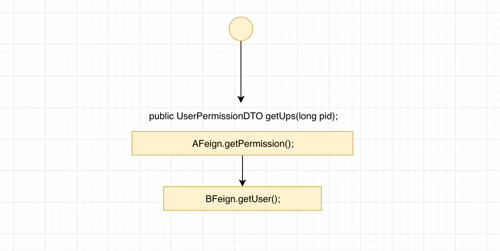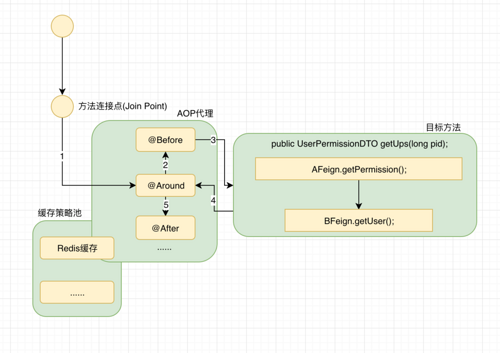基于AOP实现服务内部方法级别Cache
近期工作中,某些场景下,部分暴露的GET Feign接口被频繁调用,由于请求参数相同情况下,只是在不停的通过这个接口拿到想要的信息,比如拥有某部分权限的用户信息接口。权限服务A与用户服务B是拆分开的服务,库并不属于同一个库,所以每次都需要去服务B去获取用户信息,这种情况下对权限服务A的调用函数做缓存优化是一个不错的方案。具体情况如下图:

优化方案,使用Aop,在方法调用前,增加预处理。如果命中缓存直接从缓存中取,否则执行目标方法并缓存。优化后的如下图:

如图需要定义个缓存注解,如果该注解修饰的方法,就根据缓存策略做拦截预处理。
定义命中缓存注解
/**
* 服务内部缓存注解,方法级别注解。
* @author CoderJiA
*/
@Target({ElementType.METHOD, ElementType.TYPE})
@Retention(RetentionPolicy.RUNTIME)
@Inherited
@Documented
public @interface EasyCache {
/**
* 缓存唯一key前缀
*/
String key() default "";
/**
* 数据域表达式
*/
String fieldExps() default "";
/**
* 是否过期
*/
boolean isExpire() default false;
}
复制代码
- 缓存唯一key前缀规则:
缓存唯一key前缀
默认命名规则: ClassSimpleName#MethodName
如: A#method
class A {
public void method(){}
}
复制代码
- 数据域表达式规则:
p/coll/arr 代表支持的参数类型
0 1 代表参数下标
对象与属性用[.]标识 对象多个属性间用[&]
例:
基本数据类型: p
@EasyCache(fieldExps = "#p0=?")
public String getCacheByP(String userName);
集合类型: coll
@EasyCache(fieldExps = "#coll0=?")
public List<Long> getCacheByColl(List<Long> ids);
数组类型: arr
@EasyCache(fieldExps = "#coll0=?")
public List<Long> getCacheByArr(Long[] idArr);
上面三种组合在一起:
@EasyCache(fieldExps = "#coll0=?#p1=?#arr2=?")
public List<Long> getCacheByCom(List<Long> ids, String userName, Long[] idArr);
对象类型:
@EasyCache(fieldExps = "#coll0.ids=?&p0.userName=?#arr1=?")
public EasyCacheDemoBean getCacheByBean(EasyCacheDemoBean easyCacheDemoBean, Long[] idArr){
// 这个方法内部需要使用easyCacheDemoBean的ids与userName。
}
复制代码
- 是否过期规则:
是否过期,设置过期时间的好处是如果漏掉清楚缓存,会在过期时间外保证缓存正确结果。 开启后,默认过期时间为两分钟(easy.cache.expireTime调整默认过期时间)。 复制代码
命中缓存Aop实现
/**
* 服务内部缓存注解Aop实现
* @author CoderJiA
*/
@Aspect
@Component
public class EasyCacheAop {
@Autowired
private EasyCacheRedisStrategy easyCacheRedisStrategy;
/**
* 定义WsCache缓存注解切入点
*/
@Pointcut("@annotation(cn.coderjia.fp.cache.anno.EasyCache)")
public void easyCache() { }
/**
* 目标方法的环绕处理
*/
@Around("easyCache()")
public Object doAround(JoinPoint joinPoint) {
/**
* 缓存策略池中Redis命中缓存策略
*/
return easyCacheRedisStrategy.operate(joinPoint);
}
}
复制代码
命中缓存策略的定义与实现
针对连接点的缓存策略,可以有很多种实现,本质上就是定义一个抽象策略,然后自己根据抽象策略去做具体实现。也就是策略设计模式的一种变种应用。
- 抽象缓存策略角色的定义
/**
* 抽象缓存策略角色的定义
* @author CoderJiA
*/
public interface EasyCacheStrategy {
/**
* 定义统一缓存操作,在具体的缓存策略角色中实现。
* @param joinPoint 切入点对象
*/
Object operate(JoinPoint joinPoint);
}
复制代码
- Redis缓存命中策略的具体实现
/**
* 缓存Redis具体策略角色
* @author CoderJiA
*/
@Slf4j
@Component
public class EasyCacheRedisStrategy implements EasyCacheStrategy {
/**
* 默认过期时间为两分钟
*/
@Value("${ws.cache.expireTime:120}")
private Long expireTime;
@Resource(name = "systemRedis")
private RedisUtils redisUtils;
/**
* 缓存命中Redis具体操作
*/
@Override
public Object operate(JoinPoint joinPoint) {
Object obj = null;
try {
// 获取当前注解
EasyCache easyCache = AopCacheUtil
.getMethod(joinPoint)
.getAnnotation(EasyCache.class);
/**
* easyCache.key() 如果为"" 取ClassSimpleName#MethodName
* easyCache.fieldExps() 对表达式的一种解析
* joinPoint 连接点
*/
String key = UniqueKeyGenerator.gen(easyCache.key(), easyCache.fieldExps(), joinPoint);
log.info("CacheRedisStrategy#operate key :{}", key);
// 如果存在key直接返回
if (redisUtils.exists(key)) {
log.info("CacheRedisStrategy#operate use redis cache, cur key:{}", key);
Class<?> methodReturnType = AopCacheUtil.getMethodReturnType(AopCacheUtil.getMethod(joinPoint));
return JSON.parseObject(redisUtils.get(key), methodReturnType);
}
// 执行目标方法
Method method = AopCacheUtil.getMethod(joinPoint);
obj = method.invoke(joinPoint.getTarget(), joinPoint.getArgs());
if (easyCache.isExpire()) {
// 当前key缓存结果
redisUtils.save(key, JSON.toJSONString(obj), expireTime);
} else {
// 当前key缓存结果
redisUtils.save(key, JSON.toJSONString(obj));
}
} catch (Exception e) {
e.printStackTrace();
}
return obj;
}
}
复制代码
命中缓存注解的应用与测试
编写个Service Demo来应用@EasyCache
/**
* 缓存使用方式Demo
* @author CoderJiA
**/
@Slf4j
@Service
public class EasyCacheDemoService {
@EasyCache(fieldExps = "#p0=?", isExpire = true)
public String getCacheByP(String userName) {
return userName;
}
@EasyCache(fieldExps = "#coll0=?")
public List<Long> getCacheByColl(List<Long> ids) {
return ids;
}
@EasyCache(key = "cj_test_cache_key", fieldExps = "#arr0=?")
public Long[] getCacheByArr(Long[] ids) {
return ids;
}
@EasyCache(fieldExps = "#coll0=?#p1=?#arr2=?")
public List<Long> getCacheByCom(List<Long> ids, String userName, Long[] idArr) {
log.info("ids:{}; userName:{}; idArr:{}", idArr, userName, idArr);
return ids;
}
@EasyCache(fieldExps = "#coll0.ids=?&p0.userName=?#arr1=?")
public EasyCacheDemoBean getCacheByBean(EasyCacheDemoBean easyCacheDemoBean, Long[] idArr) {
/**
* 下面两个说明需要使用的对象属性 然后拼接方式如:
* #coll0.ids=?&p0.userName=?
* coll0 代表 ids是 集合属性
* ids 代表 该easyCacheDemoBean对象的ids属性
* & 代表他们同属于一个对象 所有p0的0代表着属于第一个参数easyCacheDemoBean
*/
log.info("easyCacheDemoBean field ids:{}", easyCacheDemoBean.getIds());
log.info("easyCacheDemoBean field userName:{}", easyCacheDemoBean.getUserName());
/**
* 这个同上的普通类型
*/
log.info("idArr:{}", Arrays.toString(idArr));
return easyCacheDemoBean;
}
}
复制代码
/**
* 缓存Demo v0.0.1
* @Author CoderJiA
**/
@RestController
@RequestMapping("easy/cache")
public class EasyCacheDemoController extends SimpleController {
@GetMapping("hitBean")
public BaseResponse hitBean() {
EasyCacheDemoBean easyCacheDemoBean = new EasyCacheDemoBean();
easyCacheDemoBean.setIds(Lists.newArrayList(5L, 6L, 7L, 8L));
easyCacheDemoBean.setUserName("coder.jia");
return buildSuccess(easyCacheDemoService.getCacheByBean(easyCacheDemoBean, new Long[]{1L,2L,3L,4L}));
}
}
复制代码
测试

查看下Redis中是已经缓存
127.0.0.1:6379> get "EasyCacheDemoService#getCacheByBean_47378635d529d2511023cf038c4ae03dbd893abc"
"/"{///"ids///":[5,6,7,8],///"userName///":///"coder.jia///"}/""
复制代码
写到这,命中缓存注解的基本策略已经满足,这里面有个地方是没有写出来,就是Redis的key生成策略,这部分其实就是ClassSimpleName#MethodName_Sha1("#coll0.ids=[5, 6, 7, 8]&p0.userName=coder.jia#arr1=[1,2,3,4]"),本质是fieldExps中的?占位符替换为参数值加上类名与方法名前缀,当然你定义了key那么前缀就是你定义的。
定义清除缓存注解
上面命中缓存已经实现,但是部分业务方法的变更是会影响掉已缓存好的值,比如拥有某个权限的用户列表,如果我把一个权限中的用户变更,那么在读取缓存值是存在无效的值,所以需要定义清除缓存注解。
/**
* 服务内部缓存注解,方法级别注解。
* @author CoderJiA
*/
@Target({ElementType.METHOD, ElementType.TYPE})
@Retention(RetentionPolicy.RUNTIME)
@Inherited
@Documented
public @interface EasyCacheEvict {
/**
* 缓存唯一key前缀列表
* 如果默认的前缀,请参见{@link cn.coderjia.fp.cache.anno.EasyCache} key的默认生成规则。
*/
String[] keys();
}
复制代码
清除缓存Aop实现
/**
* 服务内部缓存注解Aop实现
* @author CoderJiA
*/
@Aspect
@Component
public class EasyCacheEvictAop {
@Autowired
private EasyCacheEvictRedisStrategy easyCacheEvictRedisStrategy;
/**
* 定义EasyCache缓存注解切入点
*/
@Pointcut("@annotation(cn.coderjia.fp.cache.anno.EasyCacheEvict)")
public void easyCacheEvict() { }
/**
* 目标方法的后置处理,清除缓存
*/
@After("easyCacheEvict()")
public void doAfter(JoinPoint joinPoint) {
/**
* 缓存策略池中Redis清除缓存策略
*/
easyCacheEvictRedisStrategy.operate(joinPoint);
}
}
复制代码
清除缓存策略的实现
/**
* 缓存清空Redis具体策略角色
* @author CoderJiA
*/
@Slf4j
@Component
public class EasyCacheEvictRedisStrategy implements EasyCacheStrategy {
@Resource(name = "systemRedis")
private RedisUtils redisUtils;
/**
* 缓存清空Redis具体操作
* <p>注解{@link cn.coderjia.fp.cache.anno.EasyCache}的作用是某个方法的执行数据变更,导致对应的缓存失效。
* <ul>
* 例如:
* <li> public List<User> query(String name); // 查询方法</li>
* <li> public void update(String name); // 更新方法,导致查询方法的缓存失效,那么就将redis中包含查询方法定义的key前缀内容全部清空。</li>
* </ul>
* </p>
* @param joinPoint 切入点对象
*/
@Override
public Object operate(JoinPoint joinPoint) {
/*
* 获取当前注解参数
*/
EasyCacheEvict easyCacheEvict = AopCacheUtil
.getMethod(joinPoint)
.getAnnotation(EasyCacheEvict.class);
/*
* 获取影响到所有key前缀数组,并执行删除操作。
*/
String[] keys = easyCacheEvict.keys();
Optional.of(keys).ifPresent(ks -> {
log.info("EasyCacheEvictRedisStrategy#operate keys:{}", Arrays.toString(ks));
IntStream.range(0, ks.length).forEach(i -> redisUtils.removeByPrefix(ks[i]));
});
return null;
}
复制代码
在Demo中添加清除缓存的测试样例
Service
@EasyCacheEvict(keys = {
"EasyCacheDemoService#getCacheByCom"
})
public void cancelCacheCom() {
log.info("EasyCacheDemoService#cancelCacheCom...");
}
复制代码
Controller
@GetMapping("cancel")
public BaseResponse cancel() {
easyCacheDemoService.cancelCacheCom();
return buildSuccess();
}
复制代码
测试: 先生成缓存

查看下Redis中是已经缓存
127.0.0.1:6379> get "EasyCacheDemoService#getCacheByBean_47378635d529d2511023cf038c4ae03dbd893abc"
"/"{///"ids///":[5,6,7,8],///"userName///":///"coder.jia///"}/""
复制代码
调用cancel清除缓存

127.0.0.1:6379> get "WsCacheDemoService#getCacheByBean_47378635d529d2511023cf038c4ae03dbd893abc" (nil) 复制代码
正文到此结束
热门推荐
相关文章
Loading...










![[HBLOG]公众号](http://www.liuhaihua.cn/img/qrcode_gzh.jpg)

